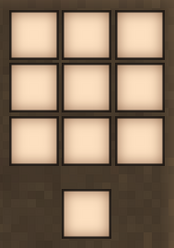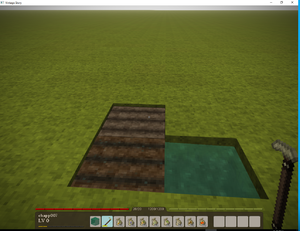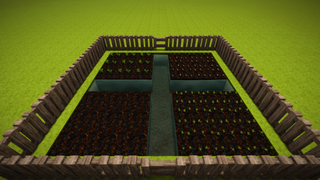農業
This page was last verified for Vintage Story version 1.16.4.
農業は、料理で使う作物を育てることができるゲームメカニクスです
To begin farming, a player needs good soil and seeds to plant crops. A specialized tool, the hoe is required to convert soil into farmland. The player will also need to provide moisture for the growing crops, either via irrigation or through the use of a watering can.
種を見つける
野生の作物はワールド生成時に作られ、世界中の様々な気候の地域に存在しています。作物を植えるための種を集めるには、これらの作物を壊すことが不可欠です。成熟していない作物は壊しても必ず種をドロップするとは限りません。野生の作物はチャンクがロードされていなくても成長し、その成長は気温の影響を受けません。しかし完全に成長した後も次の成長タイミングまでに収穫しなければ、成長段階が1に戻ってしまいます。長旅に出ていて同じ道を通らないと予想される場合は、成長段階にかかわらず全ての作物を収穫することをお勧めします。
種は、廃墟にあるルート品の容器(種と農業用)にも入っていて、この方法でしか手に入らない作物もあります。
Seeds can also be found in seed and farming loot vessels located in ruins - some crops can only be acquired this way.
| Seed Type | Product | Climate |
|---|---|---|
| Carrot | Temperate | |
| Flax | Temperate | |
| Onion | Temperate | |
| Spelt | Temperate | |
| Turnip | Temperate | |
| Parsnip | Temperate | |
| Rye | Temperate | |
| Rice | Warm | |
| Soybean | Warm | |
| Amaranth | Warm | |
| Bell Pepper | Warm | |
| Cassava | Warm | |
| Peanut | Warm | |
| Pineapple | Warm | |
| Sunflower | Warm | |
| Pumpkin | Ruins Only | |
| Cabbage | Ruins Only |
*Bell peppers are not implemented as of 1.16.4. The wild crops will grow and will drop seeds, but never any produce.
土と農地
自然に生成される土
自然に存在する土は、肥沃度の異なる4種類、やせた土(5%)、少し肥沃な土(25%)、肥沃な土(50%)、「テラ・プレタ」と呼ばれるとても肥沃な土(80%)があります。土ブロックを回収して別の場所に置いても肥沃度は保たれるため、栄養素の豊富な土を探して持ち帰るのが良い農業戦略となります。
Four types of naturally occurring soil exist in the world at different fertility rates: barren 5%, low 25%, medium 50%, and high 65%. Soil retains its fertility levels when blocks are gathered and placed elsewhere, so a good farming strategy is to hunt soil with high nutrient levels and bring it home.
プレイヤーが作る土
堆肥はプレイヤーが作成できる、栄養素65%の土です。この土は、テラ・プレタが見つからない場合の代わりの選択肢になります。堆肥ブロックは64個の腐敗物を樽の中に20日間密閉して作ります。
Terra Preta is a player-generated soil type with nutrient levels of 80%. Each block of Terra Preta is created by sealing 64 rot in a barrel for 20 days, then combining 8 of the resulting compost in the crafting grid with 4 bonemeal around 4 charcoal to create one block of Terra Preta.
| Ingredients | Crafting Recipe |
|---|---|
| 8x Compost 4x Bonemeal 4x Charcoal |
農地作り
土ブロックをクワ+右クリックで、乾いた農地を作ることができます。農地が水源ブロックから3ブロック以内にある場合、乾いた農地から湿った農地へと変化します。湿った農地を作るには毎日じょうろで水を撒くか、雨の多い地域では雨に頼るなどの方法もあります。水分量が50%以上になると成長速度にボーナスが発生します。具体的には水分が100%の場合、作物が次の段階に成長するまでの総時間が、ゲーム内時間で最大2時間短縮されます。
Using a hoe + ![]() on a soil block creates dry farmland. If the farmland is within 3 blocks of a freshwater source block, it will be converted from dry to moist farmland. Other solutions for creating moist farmland include daily watering using a watering can or relying on rain in a rainy area. Moisture levels above 50% give a bonus to growth speed. More specifically, reducing the total hours needed for a crop to grow to the next stage by up to two hours of in-game time, if at 100% moisture.
on a soil block creates dry farmland. If the farmland is within 3 blocks of a freshwater source block, it will be converted from dry to moist farmland. Other solutions for creating moist farmland include daily watering using a watering can or relying on rain in a rainy area. Moisture levels above 50% give a bonus to growth speed. More specifically, reducing the total hours needed for a crop to grow to the next stage by up to two hours of in-game time, if at 100% moisture.
近くの水は、斜め方向も含む3ブロック以内の水平方向に隣接する農地に水分を供給します。近くの水による水分ボーナスは農地が水から1ブロック離れるごとに25%ずつ減少します。そのため水ブロックに隣接する農地は75%、2ブロック離れた農地は50%、3ブロック離れた農地は25%の水分ボーナスを得ることができます。農地は垂直方向の水から水分を吸収しません(例えば湖の水面の真上に作られた農地は、下の水から水分を得られません)。
Saltwater cannot be used to provide moisture, and will instantly kill crops.
農地ブロックは拾ったり置き直したりすることができません。農地を破壊するとブロックは失われてしまいます。
土の栄養素
すべての土、泥、乾いた/湿った農地にはN、P、Kの3つの栄養素があり、それぞれの作物はこれらの栄養素のうち1つを消費します。下の表に示すように、作物によっては他の作物よりも高い栄養素を必要とするものがあります。また表の成長日数に示されているように、それぞれの作物は成長速度も異なります。
All soil, dirt, and dry or moist farmland, has 3 nutrient levels, N, P, and K. Each crop consumes one of these nutrients. Some crops require higher values of nutrients than others, as shown in the table below. Crop growth rates also differ. Each crop has a different total growth speed, which is shown by the number of growth days.
作物が次の成長段階に進むとき、植えられている農地の養分を消費します。必要な栄養素であるK、P、Nは、消費されることで農地内の濃度が低下します。成長段階ごとに必要な栄養素の量は、栄養素の消費量を成長段階の数で割ることで計算できます。
栄養素の補充
農地の栄養素は時間の経過とともにゆっくりと補充され、土の種類に応じた最大レベルに戻ります。例えば肥沃度が中程度の場合、栄養素は元のレベルまでしか戻りません。養分の補充速度は、作物が育っている場合は遅く、作物が育っていない休耕地の場合は速くなります。現在成長している作物が使用している栄養素は、使用されていない2つの栄養素よりも再生が遅くなり、作物が成長のたびに消費するため、実際のところまったく補充されません。農地の作物が熟していれば、栄養分はどれも補充されません。
栄養素の補充タイミングは、ゲーム内時間で3~4時間ごとです。
Nutrients in farmland slowly replenish over time and return to the maximum level per soil type, for instance, medium fertility will only regain nutrients to their original levels. The rate of nutrient replenishment is slower if a crop is growing on it and faster when left fallow - meaning no crop growing. The nutrition type used by the currently growing crop will regenerate even slower than the two not actively used, and effectively won't replenish at all, as the currently growing crop reduces it with every growth tick. If the crop on the farmland is ripe, none of the nutrients will replenish.
Nutrition replenishment ticks every 3 to 4 ingame hours.
輪作
輪作とは、同じ場所で異なる種類の作物を順番に栽培することであり、収穫量を最大化するために古くから行われてきました。窒素(N)、リン酸(P)、カリウム(K)に依存する作物は、同じ農地で輪作することができます。例えば、カブのような窒素に依存する作物を収穫した後の土壌は、窒素が少なく、他の2つの栄養素が多く含まれています。そのため、同じ土にリン酸やカリウムに依存する作物を植えることができます。
Crop rotation is the practice of growing a series of different types of crops in the same area over time and has been used since ancient times to maximize crop production. Nitrogen (N), phosphate (P) and potassium (K) dependent crops can be rotated on the same growing area. For example, after harvesting a nitrogen-dependent crop such as turnips, the soil will have a lower level of nitrogen but higher levels of the two other nutrients. Therefore a phosphate or potassium-dependent crop can be planted in the same soil.
一般的な輪作では肥沃な場所を4つのセクションに分け、それぞれにN、P、Kに依存する作物を植え、1つは休耕地(作物が育っていない状態)とします。右のスクリーンショットでは、左上にカブ(N依存)、右上にタマネギ(P依存)、右下にニンジン(K依存)が植えられていて、左下のエリアは何も栽培されていない状態になっています。収穫後、植え付けを時計回りに回転させると、今度は右上にカブ、右下にタマネギ、左下にニンジンが植えられ、左上には作物がない状態になります。そして収穫のたびに、再び時計回りに回転させます。
ローテーションは最も遅く成熟する作物に依存していて、今回の場合はニンジン(ゲーム内日数で4日)です。養分は休耕地で最も早く補充されるので、各ローテーションの間、1つのエリアには植えていません。この手法は、まだ肥料を入手していない場合に特に有効です。作物の種類に応じて、この手法のバリエーションを作ることができます。
肥料
例えば重要な作物である亜麻は、成長する過程で土壌中のカリウムを消費します。収穫後、枯渇した土にカリや硝石を加えればカリウムが補充され、自然の補充を待つことなく、また輪作の必要もなく、同じ土に亜麻を植えることができます。各作物に必要な栄養素の種類と量は、次の項の「利用可能な作物の表」に示されている通りです。温度と光の条件が満たされている場合、各作物に十分な栄養素があれば、最適な成長速度を得ることができます。
肥料を使うことは、各種類の土の最大栄養素レベルを超える唯一の方法です。
硝石は試掘ツルハシでは検出できず、洞窟を探索して見つける必要があることに注意してください。
| Fertilizer | Nitrogen (N) % | Phosphorus (P) % | Potassium (K) % | Obtention |
|---|---|---|---|---|
| 0 | 0 | 60 | grinding sylvite | |
| 13 | 0 | 44 | mined from caves | |
| 3 | 30 | 0 | grinding bones | |
| 40 | 8 | 8 | sealing 64 rot in a barrel for 20 days |
作物
収穫するには、素手で作物を左クリックするか、ナイフや大鎌などの収穫用の道具を使います。完全に成熟した作物からは、種と食材、そして亜麻の場合は繊維が得られます。すべての完熟した作物は、収穫時に約5%の確率で追加の種を落とします。 それぞれの作物は、「作物プロパティ」によって特徴づけられています。作物プロパティは、以下の個々のプロパティで構成されています。
To harvest, left-click on the crop with an empty hand or harvesting tool, knife or scythe. Fully mature crops will return seeds, food, and in the case of flax, fiber. All fully mature crops have about a 5% chance of dropping an extra seed when harvested. Each crop is characterized by a set of Crop Properties. Crop properties consist of the following individual properties:
- 成長段階:作物の成長段階の数です。
- 総成長日数:作物が完全に成長する(収穫可能になる)までにかかる日数です。
- 必要な栄養素:作物が次の段階に成長する際に農地から消費される栄養素(N、P、K)の種類です。
- 栄養素の消費量:作物が成長するまでに消費される、必要な栄養素の総量です。
- 耐寒性/耐熱性:作物がダメージを受けて収穫量が減ってしまうことがない、耐えられる温度の範囲です。一般的に、すべての作物は0℃以上でのみ成長を続けることができます。それ以下の温度では、ダメージを受けずに耐えられたとしても成長はできません。現在のところ、作物の成長のための温度調節は、温室を利用して温度を上げることしかできません。寒すぎたり暑すぎたりすると収穫量が半減しますが、種は必ずドロップします。
利用可能な作物の表
| 作物 | 成長段階 | 総成長日数 | 必要な栄養素 | 栄養素の消費量 | 耐寒性 | 耐熱性 |
|---|---|---|---|---|---|---|
| 7 | 4日 | K(カリウム) | 40 | -10°C | 32°C | |
| 9 | 4.2日 | K(カリウム) | 50 | -5°C | 40°C | |
| 7 | 3.6日 | P(リン) | 35 | -1°C | 40°C | |
| 9 | 4.4日 | N(窒素) | 40 | -5°C | 40°C | |
| 5 | 3日 | N(窒素) | 30 | -5°C | 27°C | |
| 8 | 6日 | P(リン) | 20 | -10°C | 32°C | |
| 10 | 4.2日 | K(カリウム) | 50 | 8°C | 40°C | |
| 9 | 5日 | N(窒素) | 40 | -5°C | 40°C | |
| 11 | 5.4日 | K(カリウム) | 35 | -5°C | 40°C | |
| 8 | 3.5日 | P(リン) | 30 | -5°C | 40°C | |
| 12 | 6.5日 | N(窒素) | 40 | -5°C | 35°C |
カボチャの栽培方法は他の作物とは異なります。カボチャ畑を作るための詳しい手順は、カボチャのページをご覧ください。
| Crop | Growth Stages |
Total Growth | Nutrient | Nutrient Consumption |
Temperature Resistance | Yield | ||
|---|---|---|---|---|---|---|---|---|
| Months | Days* | Cold | Heat | |||||
| 7 | 1.20 | 10.80 | K (Potassium) | 40 | -10°C | 32°C | 9-13 | |
| 9 | 2.00 | 18.00 | K (Potassium) | 50 | -5°C | 40°C | 5-7** | |
| 7 | 1.85 | 16.65 | P (Phosphorus) | 35 | -1°C | 40°C | 10-14 | |
| 9 | 2.00 | 18.00 | N (Nitrogen) | 40 | -5°C | 40°C | 10-14 | |
| 5 | 1.00 | 9.00 | N (Nitrogen) | 30 | -5°C | 27°C | 6-8 | |
| 8 | 2.00 | 18.00 | P (Phosphorus) | 20 | -10°C | 32°C | 10-14 | |
| 10 | 2.25 | 20.25 | K (Potassium) | 50 | 8°C | 46°C | 11-15 | |
| 9 | 2.00 | 18.00 | N (Nitrogen) | 40 | -12°C | 27°C | 9-13 | |
| 11 | 1.25 | 11.25 | K (Potassium) | 35 | -5°C | 40°C | 5-7 | |
| 9 | 2.00 | 18.00 | N (Nitrogen) | 15 | 6°C | 42°C | 5-7 | |
| 19 | 2.20 | 19.80 | N (Nitrogen) | 35 | 8°C | 34°C | Not implemented | |
| 9 | 5.00 | 45.00 | K (Potassium) | 25 | 4°C | 44°C | 14-18 | |
| 9 | 2.50 | 22.50 | P (Phosphorus) | 45 | 10°C | 42°C | 8-12 | |
| 16 | 6.00 | 54.00 | N (Nitrogen) | 15 | 6°C | 48°C | 1 | |
| 12 | 1.85 | 16.65 | N (Nitrogen) | 40 | -5°C | 40°C | 11-15 | |
| 8 | 1.70 | 15.30 | P (Phosphorus) | 30 | -5°C | 40°C | Variable*** | |
| 12 | 1.50 | 13.50 | N (Nitrogen) | 40 | -5°C | 35°C | 2 | |
* Growth times are calculated based on number of days in a month. Changing the length of a month will change the total growth time in days proportionally.
** 5-7 grains, 7-9 fibers
*** Pumpkins are cultivated differently than all other crops. Please see the pumpkin page for detailed instructions about establishing a pumpkin patch.
Fruit trees
Fruit trees were introduced in the Homesteading Update (v.1.16). There are a total of nine different types of fruit-bearing trees: red apple, pink apple, yellow apple, peach, pear, cherry, orange, olive, and mango. Some of the trees, like mango and orange, are specifically adapted to warmer climates, whereas apples, pears, and peaches thrive in temperate climates.
After a fruit tree is found in the wild, a tree cutting can be acquired by breaking its branches with an 斧. Each cutting has a 40% chance to grow into a full tree when planted in the ground - if the temperature requirements are met. Some trees must go through "vernalization," when the temperature drops down below a certain point, for them to set fruit.
動物の襲撃
農場を作るときに注意しなければならないのは、植えた作物をウサギが狙って食べてしまうことです。植物の成熟度によっては種がドロップしますが、放っておけばすぐにデスポーンしてしまいます。
ウサギは草ブロックにスポーンするため、農場の防ウサギを実現するためには、農場のブロックの周りに壁や柵、または2ブロックの深さの乾いた堀を設置し、囲まれたエリアには草ブロックを残さないようにすることをお勧めします。乾いた堀を使う場合、お腹を空かせたウサギが作物にたどり着こうとするところを捕まえることができるというメリットがあります。
ウサギに食べられない作物は少なく、具体的には米、タマネギ、カボチャです。これらの作物は保護せずに植えることができますが、米やタマネギは他の植物と輪作する必要があり、その場合はやはりウサギから守らなければなりません。
ウサギは野生の作物を無視します。
Hares will go after planted crops and eat them. They will leave behind a dead plant that drops one seed, but no crops. Some crops are not eaten by hares, namely onions, pineapples, and pumpkins. These can be planted without protection if grown alone.
Since hares spawn on grass blocks, rabbit-proofing farms with walls, fences, or a two-block deep dry moat around farm blocks is recommended. Players must take care to leave no grass blocks within the enclosed area. The moat has the bonus of catching hungry hares when they try to reach the player's crops. Keep in mind that adult hares can jump over a single fence block if it is waterlogged and then frozen. Hare spawns can also be blocked inside an enclosed area by placing stones on the ground or removing all blocks that could grow grass. Grass that grows on fallow farm blocks is not a valid spot for hares to spawn because tilled farmland isn't a full block.
Hares ignore wild crops.
地下農業
バージョン1.14から、地下での農業は簡単にはできなくなりました。海面からの深さに応じて植物の成長に軽い制限がかかるようになり、海面から1レベル下がるごとに作物の成長に必要な光量が1つ増え、光量19以下では1レベル下がるごとに10%の成長ペナルティが発生し、光量9で完全に成長が停止するようになっています。
Version 1.14 introduced significant limitations on underground farming. There is a soft limit for plant growth concerning depth below sea level. Each level below sea level requires one extra light level for the crop to grow, and below light level 19, each farther level incurs a 10% growth penalty, which means growth will stop entirely at or below light level 9.
太陽の光量が22であることを考えると、ライトシャフト(空と農地を直接つなぐ穴)だけで成長のペナルティを受けることなく最大で海面下3段、成長が完全に止まるまでに最大で海面下12段まで農地を設置できることになります。 シャンデリアをフルにセットした場合、光量が24になるので、もう少し低い位置でも可能になります。ただし光量は累積されないため、光量22のライトシャフトと光量18のランタンを組み合わせても、最大光量は22となります。
With a fully set chandelier (providing light level 24), a slightly lower depth might be reached. However, light levels do not accumulate, meaning combining a light shaft with light level 22 and a lantern with light level 18 will still result in a maximum light level of 22.
しかし海抜を越える山の中に農地を作ることで、太陽や人工光で成長に必要な光量を確保できれば、「地下」農場はまだ実現可能です。
デフォルトの高さのワールドでは海面は110になります。
The efficiency values below in the "Satiety/Growth time (days)" column are based on the average yield of a crop from one tile of farmland, multiplied by the food's satiety, divided by the number of growth days until maturity. Note that pumpkins, while they only require a single block of farmland, are spread out to cover a wider area of dirt. This space efficiency was not taken into account.
| Seed Type | Category | Satiety | Satiety/Growth time (days) | ||||
|---|---|---|---|---|---|---|---|
| Raw | 料理 | 料理 | Raw | 料理 | 料理 | ||
| Vegetable | 100 | 150 | N/A | 75.00 | 112.50 | N/A | |
| Grain | 30 | 120 | 160 | 10.58 | 42.35 | 53.33 | |
| Vegetable | 100 | 150 | N/A | 75.00 | 112.50 | N/A | |
| Grain | 60 | 240 | 300 | 40.00 | 160.00 | 200.00 | |
| Vegetable | 100 | 150 | N/A | 100.00 | 150.00 | N/A | |
| Vegetable | 100 | 150 | N/A | 50.00 | 75.00 | N/A | |
| Grain | 60 | 280 | 330 | 40.00 | 186.67 | 211.85 | |
| Grain | 60 | 240 | 300 | 36.00 | 144.00 | 183.33 | |
| Protein | 150* | 240 | N/A | 81.82 | 130.91 | N/A | |
| Grain | 60 | 240 | 300 | 20.00 | 80.00 | 100.00 | |
| Vegetable | 100 | 120 | N/A | 35.71 | 42.86 | N/A | |
| Grain | N/A | N/A | 300 | N/A | N/A | 106.67 | |
| Protein | 160 | N/A | N/A | 73.85 | N/A | N/A | |
| Fruit | 320* | 480* | N/A | 6.67 | 10.00 | N/A | |
| Grain | 60 | 240 | 300 | 48.00 | 192.00 | 234.23 | |
| Vegetable | 480* | 720* | N/A | 102.86 | 154.28 | N/A | |
| Vegetable | 300 | 450 | N/A | 46.15 | 69.23 | N/A | |
- Soybeans cannot be eaten raw, but they can be pickled and then eaten in this state.
- Cassava cannot be eaten raw off the vine. It must first be soaked in a sealed barrel and skinned with a knife, but it can then be eaten in this state.
- Pineapples and pumpkins cannot be eaten nor cooked whole. They must first be sliced with a knife, producing 4 pieces each with exactly 25% of the entire produce's satiety.
- Pumpkins' growth varies wildly, but community experimentation appears to have resulted in approximately 1.5 pumpkins' profit per vine, on average (assuming 2.5 are grown and 1 is used to produce the next pumpkin seed). The numbers above reflect this.
History
- In version 1.19.0-rc.1, High Fertility Soil was changed to occur naturally in the world, and Terra Preta can only be crafted.[1] The recipe for Terra Preta in 1.19 is more expensive than the recipe for High Fertility Soil was in 1.18.
Notes
- It is recommended to harvest all wild crops, regardless of growth stage, when out on a long journey, if the player foresees that they will not come the same way again.
Gallery
See also
ビデオチュートリアル
| バージョン1.13の変更点を含む詳説 | カボチャの詳説 |
|---|---|
| Detailed explanation including changes since version 1.13 | Detailed explanation of pumpkin plants |
|---|---|
References
- ↑ "Tweak: Terra Preta is no longer generated during worldgen. High fertility soil will be generated instead. Terra Preta is now made in the crafting grid, as high fertility soil was previously. However crafting Terra Preta requires charcoal and bone meal, in addition to compost. High fertility soil can be included in the recipe, to increase the yield of Terra Preta." Official Devlog
| Farming | |
|---|---|
| Wild foods | Berries • Cactus (saguaro) fruit • Mushrooms • Cattail (and papyrus) |
| Grains | Amaranth • Cassava • Flax • Rice • Rye • Spelt • Sunflower |
| Vegetables | Cabbage • Carrot • Onion • Turnip • Parsnip • Peanut • Pumpkin • Soybean |
| Fruits | Fruit trees • Pineapple |
| Other | Fertilizer • Beekeeping • Room |
| Tools | Hoe • Scythe • Fruit press |
| See also | Animal husbandry • Cooking • Food preservation |
| Wiki Navigation | |
|---|---|
| Vintage Story | Guides • Frequently Asked Questions • Soundtrack • Versions • Controls |
| Game systems | Crafting • Knapping • Clay forming • Smithing • Cooking • Temperature • Hunger • Mining • Temporal stability • Mechanical power • Trading • Farming • Animal husbandry |
| World | World generation • Biomes • Weather • Temporal storms |
| Items | Tools • Weapons • Armor • Clothing • Bags • Materials • Food |
| Blocks | Terrain • Plants • Decorative • Lighting • Functional • Ore |
| Entities | Hostile entities • Animals • NPCs • Players |
| Miscellaneous | List of client commands • List of server commands • Creative Starter Guide • Bot System • WorldEdit • Cinematic Camera • Adjustable FPS Video Recording • ServerBlockTicking |


